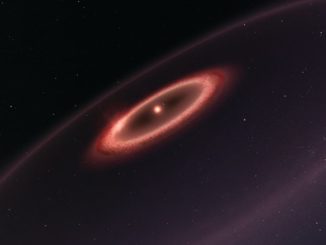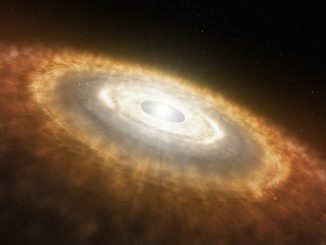
red dwarf


ALMA discovers cold dust around nearest star
The ALMA Observatory in Chile has detected dust around the closest star to the Solar System, Proxima Centauri. These new observations reveal the glow coming from cold dust in a region between one to four times as far from Proxima Centauri as the Earth is from the Sun. The data also hint at the presence of an even cooler outer dust belt and may indicate the presence of an elaborate planetary system.

Mini-flares potentially jeopardise habitability of planets circling red dwarf stars
Cool dwarf stars are hot targets for exoplanet hunting right now. The discoveries of planets in the habitable zones of the TRAPPIST-1 and LHS 1140 systems, for example, suggest that Earth-sized worlds might circle billions of red dwarf stars, the most common type of star in our galaxy. But, like our own sun, many of these stars erupt with intense flares. Are red dwarfs really as friendly to life as they appear, or do these flares make the surfaces of any orbiting planets inhospitable?

Breakthrough Listen searches new-found nearby planet Proxima b for signs of ET
Breakthrough Listen, the 10-year, $100-million astronomical search for intelligent life beyond Earth launched in 2015 by Internet entrepreneur Yuri Milner and Stephen Hawking, has just announced its first observations of newly-discovered Earth-size planet Proxima b orbiting the nearest star to the Sun using the Parkes Radio Telescope in New South Wales, Australia.

Oldest known planet-forming circumstellar disc discovered
A group of citizen scientists and professional astronomers joined forces to discover an unusual hunting ground for exoplanets. They found a red dwarf, called AWI0005x3s, surrounded by the oldest known circumstellar disc — a 45-million-year-old primordial ring of gas and dust orbiting the star from which planets can form.

Proxima Centauri might be more Sun-like than we thought
Astronomers recently announced that the nearby star Proxima Centauri hosts an Earth-sized planet in its habitable zone. Proxima Centauri is a small, cool, red dwarf star only one-tenth as massive and one-thousandth as luminous as the Sun. However, new research shows that it is Sun-like in one surprising way: it has a regular cycle of starspots.

Best image of Alpha Centauri A and B
The NASA/ESA Hubble Space Telescope has given us this stunning view of the closest bright stars Alpha Centauri A (on the left) and Alpha Centauri B (on the right), at a distance of 4.3 light-years from the Earth. The Alpha Centauri group is completed by a faint red dwarf, Proxima Centauri (not shown), recently revealed to possess an Earth-like planet orbiting in its habitable zone.

Is Earthly life premature from a cosmic perspective?
The universe is 13.8 billion years old, while our planet formed just 4.5 billion years ago. Some scientists think this time gap means that life on other planets could be billions of years older than ours. However, new theoretical work suggests that present-day life is actually premature from a cosmic perspective.

White dwarf lashes red dwarf with mystery ray
Astronomers have discovered a new type of exotic binary star. In the system AR Scorpii a rapidly spinning white dwarf star powers electrons up to almost the speed of light. These high energy particles release blasts of radiation that lash the companion red dwarf star, and cause the entire system to pulse dramatically every 1.97 minutes with radiation ranging from the ultraviolet to radio.

Hubble makes first atmospheric study of Earth-sized exoplanets
Astronomers using the NASA/ESA Hubble Space Telescope have conducted the first search for atmospheres around temperate, Earth-sized planets beyond our solar system. They found indications that increase the chances of habitability on two exoplanets known as TRAPPIST-1b and TRAPPIST-1c orbiting a red dwarf star approximately 40 light-years away.
